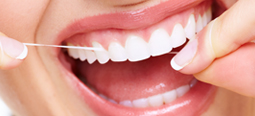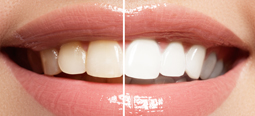
A beautiful smile brings radiance to every face. This is why it is important to maintain proper oral hygiene to never lose that smile. Since it is scientifically proven that a smile will cost you less lines than a frown, there should be no excuse to you practicing that smile. When proper hygiene is not maintained, this may sadly result in you losing your smile. These are some of the problems that you may encounter by ignoring the proper hygiene for oral health:
• Bad breath - which is an embarrassing problem to have. It doesn’t help that as the saying goes “sometimes you are the very last to know.”
• Tooth Decay - also known as cavities is another common dental problem. This can be avoided with a few tricks.
• Gum Disease - is common in many adults and can be caused by factors such as smoking and diabetes.
Three Signs of a Healthy Mouth
Proper oral hygiene is necessary to ensure that we have a healthy mouth. There are three signs that you can use to tell you if your mouth is healthy:
1. Clean teeth that does not feel covered with grime.
2. Pink gums are usually sign of good health especially when no bleeding is evident.
3. Absence of bad breath
While these three signs may indicate that you have a healthy mouth, proper oral hygiene must continue to be maintained. It is important to remember that most oral problems build up over time so an indication of the three signs above may not be present in the next couple of years. It all depends on how well you take care of your mouth.
Proper Oral Hygiene
Many of us already know the basics of proper oral hygiene but how many of us actually follow through with these practices? Even when we follow through these practices, how many of us actually take care to follow these procedures properly?
1. Brushing your teeth. Brushing your teeth is something that is necessary. The teeth should be brushed at least twice per day with fluoride toothpaste. It is recommended that proper brushing of the teeth should last no less than two minutes. The teeth should be brushed away from the gum line to prevent damage but take care to brush the inner and outer surfaces as well as the chewing areas. And don’t forget to scrub the tongue!
2. Flossing. Brushing alone is not effective and flossing is required to get into real tight spots. When flossing, use the index and middle finger to control the floss as you rub up and down between the teeth.
3. Mouthwash. The use of mouthwash is highly recommended unless your dentist tells you otherwise. When using a mouthwash ensure it’s a fluoride solution. Pour approximately 20ml into the cup and then into your mouth. Try to maintain the solution for at least thirty seconds with gargling before spitting in the sink.
Smoking
Smoking by itself can work against all the proper oral care that you have been taking. It brings with it so much risk that it is beneficial to just quit. Not only does smoking stain your teeth with tobacco and gives you bad breath but increases your chance of plaque build-up, loss of bone in the jaw, gum disease, less success rate of Dental Crowns Sydney and oral cancer.
Considering that the teeth serve both practical and beautification purposes, it is imperative to take good care of our mouth. We do this by practicing proper oral hygiene care daily. In addition to the information mentioned above, a regular visit to the Laser Dentists office is recommended.
• Bad breath - which is an embarrassing problem to have. It doesn’t help that as the saying goes “sometimes you are the very last to know.”
• Tooth Decay - also known as cavities is another common dental problem. This can be avoided with a few tricks.
• Gum Disease - is common in many adults and can be caused by factors such as smoking and diabetes.
Three Signs of a Healthy Mouth
Proper oral hygiene is necessary to ensure that we have a healthy mouth. There are three signs that you can use to tell you if your mouth is healthy:
1. Clean teeth that does not feel covered with grime.
2. Pink gums are usually sign of good health especially when no bleeding is evident.
3. Absence of bad breath
While these three signs may indicate that you have a healthy mouth, proper oral hygiene must continue to be maintained. It is important to remember that most oral problems build up over time so an indication of the three signs above may not be present in the next couple of years. It all depends on how well you take care of your mouth.
Proper Oral Hygiene
Many of us already know the basics of proper oral hygiene but how many of us actually follow through with these practices? Even when we follow through these practices, how many of us actually take care to follow these procedures properly?
1. Brushing your teeth. Brushing your teeth is something that is necessary. The teeth should be brushed at least twice per day with fluoride toothpaste. It is recommended that proper brushing of the teeth should last no less than two minutes. The teeth should be brushed away from the gum line to prevent damage but take care to brush the inner and outer surfaces as well as the chewing areas. And don’t forget to scrub the tongue!
2. Flossing. Brushing alone is not effective and flossing is required to get into real tight spots. When flossing, use the index and middle finger to control the floss as you rub up and down between the teeth.
3. Mouthwash. The use of mouthwash is highly recommended unless your dentist tells you otherwise. When using a mouthwash ensure it’s a fluoride solution. Pour approximately 20ml into the cup and then into your mouth. Try to maintain the solution for at least thirty seconds with gargling before spitting in the sink.
Smoking
Smoking by itself can work against all the proper oral care that you have been taking. It brings with it so much risk that it is beneficial to just quit. Not only does smoking stain your teeth with tobacco and gives you bad breath but increases your chance of plaque build-up, loss of bone in the jaw, gum disease, less success rate of Dental Crowns Sydney and oral cancer.
Considering that the teeth serve both practical and beautification purposes, it is imperative to take good care of our mouth. We do this by practicing proper oral hygiene care daily. In addition to the information mentioned above, a regular visit to the Laser Dentists office is recommended.

